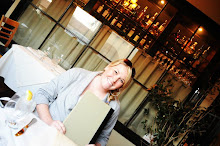(This is a guest post by Sabine Donner and Nadine Tinne, SPIE Student Chapter members who spent the end of May in Sweden at Biophotonics '11)
Last week we wrote about our expectations going into Biophotonics '11, and now that school has finished for the summer, we wanted to check back in to share a bit of our experience and encourage you all to find ways to get in touch with others in your own fields of research.
The tiny island of Ven between Denmark and Sweden hosted 15 professors and 64 students from 18 countries who joined the Biophotonics ’11 Summer School. Seven days was hardly enough time to sufficiently discuss topics of biomedical optics, hear lectures and make friends!
Dr. Katarina Svanberg (SPIE’s president) and the many other lecturers shared deep insights with us into their fields of research, including OCT, photodynamic therapy, and tumor imaging, and also motivated us to use photonics to fulfill unmet clinical needs. They emphasized the many ways that photons and their interactions with biological tissue can be used to improve medical treatments.
In addition to the fascinating lectures, there were also many opportunities to network with the other students and experts as well. Poster sessions gave us the chance to present our research to the group and learn about others’ fields of study. This gave rise to plenty of new ideas which were discussed in coffee breaks, lunch and dinner conversations.
The Swedish student delegation organized bike tours and a quiz walk, which gave us a greater sense of place and helped the group members get to know one another.
It was thrilling to spend a week getting to know the current and future experts in the field of biomedical optics, who were not only willing to share their extensive knowledge, but also their motivation and enthusiasm for biomedical research. Whether you’re a student or a professor, if you have the chance to take part in something like this, we definitely encourage you to not pass it up!
Last week we wrote about our expectations going into Biophotonics '11, and now that school has finished for the summer, we wanted to check back in to share a bit of our experience and encourage you all to find ways to get in touch with others in your own fields of research.
The tiny island of Ven between Denmark and Sweden hosted 15 professors and 64 students from 18 countries who joined the Biophotonics ’11 Summer School. Seven days was hardly enough time to sufficiently discuss topics of biomedical optics, hear lectures and make friends!
Dr. Katarina Svanberg (SPIE’s president) and the many other lecturers shared deep insights with us into their fields of research, including OCT, photodynamic therapy, and tumor imaging, and also motivated us to use photonics to fulfill unmet clinical needs. They emphasized the many ways that photons and their interactions with biological tissue can be used to improve medical treatments.
In addition to the fascinating lectures, there were also many opportunities to network with the other students and experts as well. Poster sessions gave us the chance to present our research to the group and learn about others’ fields of study. This gave rise to plenty of new ideas which were discussed in coffee breaks, lunch and dinner conversations.
The Swedish student delegation organized bike tours and a quiz walk, which gave us a greater sense of place and helped the group members get to know one another.
It was thrilling to spend a week getting to know the current and future experts in the field of biomedical optics, who were not only willing to share their extensive knowledge, but also their motivation and enthusiasm for biomedical research. Whether you’re a student or a professor, if you have the chance to take part in something like this, we definitely encourage you to not pass it up!



Comments
Post a Comment